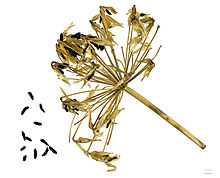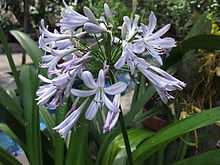Agapanthus praecox
| Blue Lily or African Lily | |
|---|---|
 | |
| Scientific classification | |
| Kingdom: | Plantae |
| Clade: | Angiosperms |
| Clade: | Monocots |
| Order: | Asparagales |
| Family: | Amaryllidaceae |
| Subfamily: | Agapanthoideae |
| Genus: | Agapanthus |
| Species: | A. praecox |
| Binomial name | |
| Agapanthus praecox Willd. | |

Agapanthus praecox (Common Agapanthus,[1] Blue Lily,[1] African Lily,[2] or Lily of the Nile[3]) is a native of Natal and Cape of Good Hope in South Africa. Local names for this species include agapant, bloulelie, isicakathi and ubani.[1] Most of the cultivated plants of the genus Agapanthus are hybrids or cultivars of this species.[1] The plant is reportedly naturalized in Great Britain, Madeira, the Canary Islands, Eritrea, Ethiopia, St. Helena, Victoria, Norfolk Island, New Zealand, Mexico, Honduras, Costa Rica and Tristan da Cunha.[4]
Description
Agapanthus praecox is a variable species with open-faced flowers. It is divided into three subspecies: subsp.praecox, subsp. orientalis and subsp. minimus.[1]
Agapanthus praecox subsp. praecox
This subspecies occurs in Eastern Cape province of South Africa. It usually grows to between 0.8 and 1 metre tall and has 10-11 leathery leaves. The blue flowers, appear from December to February.[1] These have perianth segments which are greater than 50 mm in length.[1]
Agapanthus praecox subsp. orientalis

This subspecies occurs in Eastern Cape and southern KwaZulu-Natal. Although it is about the same height as subsp. praecox, it has up to 20 poisonous, strap-like leaves per plant which are arching and are not leathery.[1] These range in length from 20 to 70 cm long and 3 to 5 cm wide.[5] Flower colour ranges from blue to white.[1][3] Shiny black seeds are produced in three-sided capsules.[3] These have perianth segments which are less than 50 mm in length.[1]
Agapanthus praecox subsp. minimus
Occurring in the southeastern Western Cape and Eastern Cape, this subspecies is the smallest, ranging in height from 300 to 600 mm. It has a longer flowering season, from November to March. Flower colour includes white and various shades of blue.[1]
Naturalisation
The species is naturalised in Australia,[3] New Zealand[6] and the Isles of Scilly.[7]
Agapanthus praecox subsp. orientalis is highly regarded for being tough in sun and heat, long-flowering, and is a favourite for many councils in Australia for the landscaping of roads and other public areas which do not get watered. The plant is still widely planted but in some areas it is considered a weed, and planting has been discontinued,[8] although it is not generally regarded as highly invasive.
See also
References
- ↑ 1.0 1.1 1.2 1.3 1.4 1.5 1.6 1.7 1.8 1.9 1.10 "Agapanthus praecox Willd.". PlantZAfrica.com. South African National Biodiversity Institute. Retrieved 2008-07-20.
- ↑ "Taxon: Agapanthus praecox Willd.". Germplasm Resources Information Network (GRIN). United States Department of Agriculture, Agricultural Research Service, Beltsville Area. Retrieved 2008-07-20.
- ↑ 3.0 3.1 3.2 3.3 "Agapanthus - Weeds of Blue Mountains Bushland". Archived from the original on 20 July 2008. Retrieved 2008-07-20.
- ↑ Kew World Checklist of Selected Plant Families
- ↑ "Agapanthus praecox subsp. orientalis (F.M.Leight.) F.M.Leight.". PlantNET - New South Wales Flora Online. Royal Botanic Gardens & Domain Trust, Sydney Australia. Archived from the original on 15 August 2008. Retrieved 2008-07-20.
- ↑ "Agapanthus praecox". Weeds Index. Environment Bay of Plenty. Archived from the original on 2008-06-21. Retrieved 2008-07-20.
- ↑ "Weird Weeds of Scilly". The Islander. Retrieved 2008-07-20.
- ↑
External links
| Wikimedia Commons has media related to Agapanthus praecox. |
- PlantZAfrica.com - Agapanthus praecox